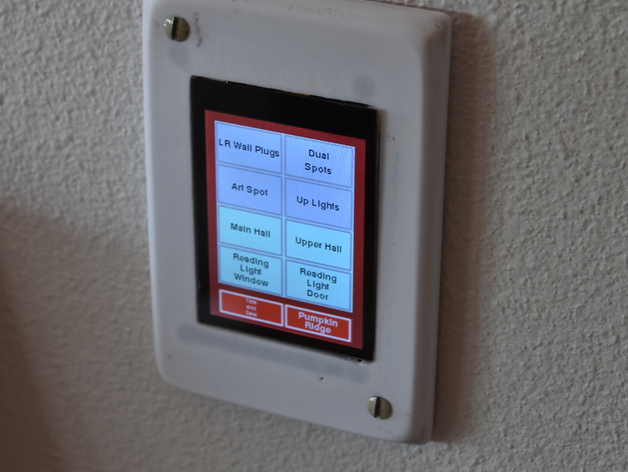
Single gang mounting system for RaspberryPi with Touchscreen
thingiverse
This set of parts enables mounting a Raspberry Pi 0 with an Adafruit 2.8" Touchscreen (model 2423 or 2298) into a single gang wall box, making room for an Insteon micro on/off or dimmer. Two versions are available - one designed to print the outer face down and another with the outer face up. To print the first version without unsightly support that screw holes for mounting the faceplate require separate inserts. The space for the micro switch and a small hole in the faceplate allow one to use a paper clip to perform a power reset on the Pi, enabling it to be restarted if needed without cycling a circuit breaker. For a discussion of the software being used with this and related items, see: http://forum.universal-devices.com/topic/18026-soft-keypadlinc-like-console-from-raspberry-pi/ and http://forum.universal-devices.com/topic/19124-wall-mount-rpi-with-28-touchscreen/ Rev2: faceplateV9 is an improved faceplate with better thinning on the back for protrusions of the PiTFT. Printing the faceplate face down yields a great smooth finish on the large flat part but in my experience, pretty marginal side curves are achieved. Printing it face up, which may seem counter-intuitive, results in pretty good flat parts and great sides. Sanding out the flat part down to 800 grit or better will then yield a very nice result, particularly if you need to paint it to match commercial plates nearby (mine needed to be ivory). Assembly notes: After answering various questions in the UDI forum about how this gets assembled, I thought it was worthwhile to summarize some of the info here. The Pi0 is mounted to the display using a straight-through header that needs to be soldered to it on the component side of the board. It then plugs directly into the bottom of the display. The power supply designed for this is a Hi-Link PM01 (e.g., https://www.amazon.com/Hi-link-HLK-PM01-Step-Down-Intelligent-Household/dp/B01B7G6LYE), available for $3 or less on Amazon, eBay, etc. It also uses a standard microswitch to allow power reset of the Linux system without pulling the breaker. The output of the power supply is wired through the microswitch with jumpers to the usb power port of the Pi0. I used a micro-usb OTG adapter like this one: https://www.adafruit.com/products/2910 (also available on eBay, etc.) with the power and ground jumpers soldered to the outside pins (power/+5 to pin 1 and ground/-5 to pin 4). This allows easier assembly than soldering power directly to the Pi0 board power pads. I also use a micro WiFi adapter in the Pi0 usb port. Heat shrink is used over all exposed wires. An Insteon micro on/off or dimmer fits on the lower shelf if desired to control a local load. It should go without saying that this is NOT UL approved. Having said that, the design keeps the 120v below the horizontal bulkhead with the exception of the soldering of the 120v input to the power supply. This physically separates the 120 and 5 volt parts of the design. Use at your own risk. Print Settings: Rafts: No Supports: Yes Notes: I print the bracket in PLA but the faceplate with PETG
With this file you will be able to print Single gang mounting system for RaspberryPi with Touchscreen with your 3D printer. Click on the button and save the file on your computer to work, edit or customize your design. You can also find more 3D designs for printers on Single gang mounting system for RaspberryPi with Touchscreen.
